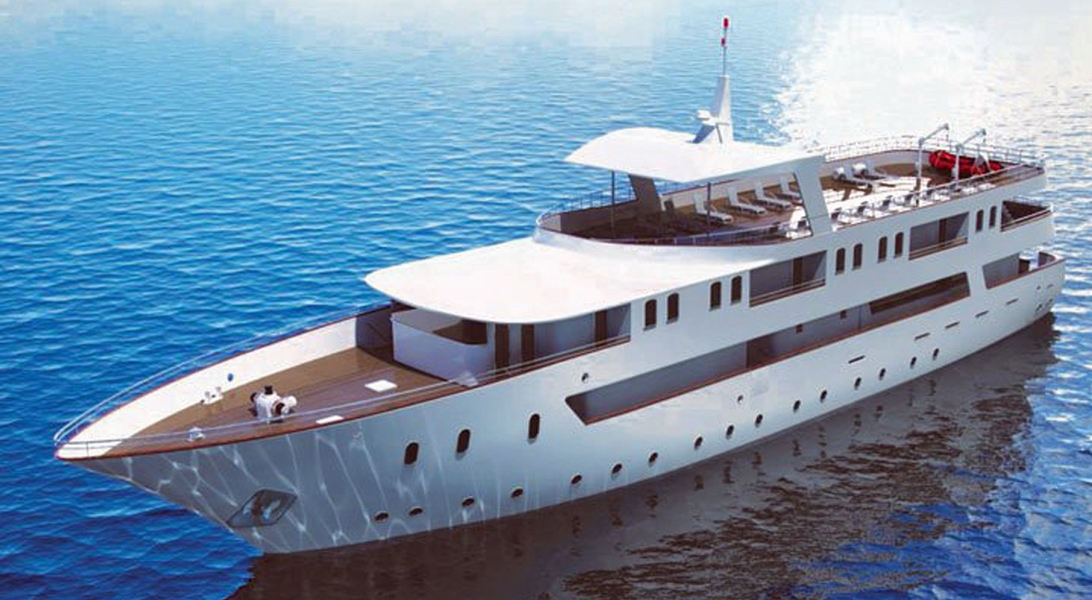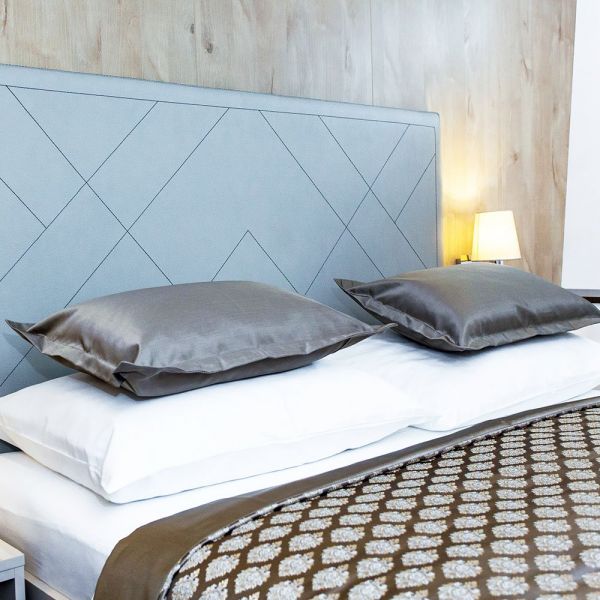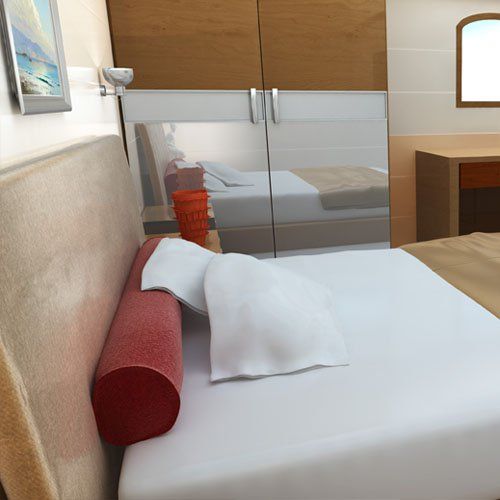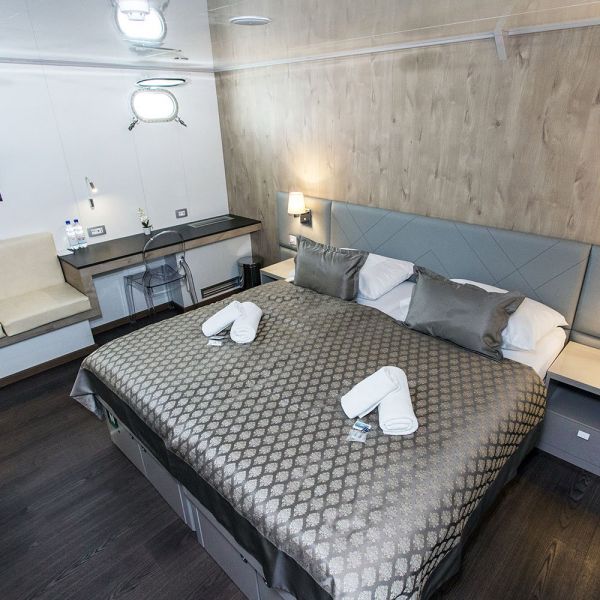This site uses cookies as defined in our Cookie Policy, by continuing to use this site you agree to their use.
Continue
| Arrive | Depart | ||||||
| 27th27 | MayMay | 202525 | Split, Croatia, embark on the MS Adriatic Sun | ||||
Split's ancient core is so spectacular and unusual that a visit is more than worth your time. The heart of the city lies within the walls of Roman emperor Diocletian's retirement palace, which was built in the 3rd century AD. Diocletian, born in the nearby Roman settlement of Salona in AD 245, achieved a brilliant career as a soldier and became emperor at the age of 40. In 295 he ordered this vast palace to be built in his native Dalmatia, and when it was completed he stepped down from the throne and retired to his beloved homeland. Upon his death, he was laid to rest in an octagonal mausoleum, around which Split's magnificent cathedral was built.In 615, when Salona was sacked by barbarian tribes, those fortunate enough to escape found refuge within the stout palace walls and divided up the vast imperial apartments into more modest living quarters. Thus, the palace developed into an urban center, and by the 11th century the settlement had expanded beyond the ancient walls.Under the rule of Venice (1420–1797), Split—as a gateway to the Balkan interior—became one of the Adriatic's main trading ports, and the city's splendid Renaissance palaces bear witness to the affluence of those times. When the Habsburgs took control during the 19th century, an overland connection to Central Europe was established by the construction of the Split–Zagreb–Vienna railway line.After World War II, the Tito years saw a period of rapid urban expansion: industrialization accelerated and the suburbs extended to accommodate high-rise apartment blocks. Today the historic center of Split is included on UNESCO's list of World Heritage Sites. Arrival in Split - On arrival in this historic city, you will be escorted to the harbour and the superb four-star MS Adriatic Sun, your home for the next seven nights. The captain and crew will be on hand to welcome you and then, having settled into your comfortable cabin and surroundings, our adventure begins! For the rest of the day, it’s time to relax and get to know your fellow passengers – there are just thirty-nine of you in total! Perhaps you’ll catch some ‘rays’ on the sun deck or take a stroll ashore. It’ll soon be time for dinner and the ship’s restaurant awaits. Perhaps later take an after-dinner stroll ashore in this most magical of cities. | |||||||
| 28th28 | MayMay | 202525 | Korčula, Croatia | ||||
Off the coast of Croatia in the southern Adriatic Sea lie some thousand islands and the largest of them, Korçula, is considered the most beautiful. With an average of 3,000 hours of sunshine per annum, which guarantees a wide assortment of Mediterranean vegetation, it is not difficult to understand why seasoned travelers compare Korçula to a latter-day Eden. Separated from the mainland by a channel of only one mile, Korçula's main town, named the same as the island, ranks among the best preserved medieval towns in the Mediterranean. It is the island's main tourist, economic and cultural center. Thanks to its strategic location along the sea trade routes, Korçula has always attracted travelers and settlers. Korcula was founded by Greek colonists, who were followed by Illyrians, Romans and finally the Croats. The Korçula Statute of 1214 is one of the oldest legal documents to have been adopted in this part of Europe. The same century saw the birth of the famous world traveler, Marco Polo. The house said to be his birthplace can be seen in town. Korçulans have always been known as keen seafarers, excellent shipbuilders, stonemasons and artists. From their many voyages, sailors brought back new ideas, which eventually mixed with local customs. To this day, Korçula has maintained the tradition of performing knightly games such as the chivalrous Moreska dance, which has been in existence for more than 400 years. Visitors to Korçula enjoy its stunning location, natural beauty and medieval ambiance. And if that's not enough, the town offers numerous attractions that are within walking distance from the pier, including the City Museum and the Bishop's Treasury. Korčula - As you rise refreshed in the morning and enjoy a leisurely breakfast, you’ll be so glad you chose this holiday. The MS Adriatic Sun, our home for the next week and every inch the private yacht, slips out of the harbour and out to sea. Split soon fades into the distance but we will of course return at the end of our cruise. It is impossible for large cruise liners to visit the charming and almost deserted hamlets accessible to our smaller yacht cruiser. We will have time for a swim stop this morning before enjoying a delicious lunch on board, as stunning views of this spectacular coastline drift by and it’s not long before we arrive into the historic town of Korčula. Ruled by the Venetians for 800 years, it is rather reminiscent of a much smaller Dubrovnik, with its host of tangled lanes so typical of medieval Mediterranean ports. The town is a charming small fortress, celebrated for supplying timber for the wooden walls of Venice and its harbour was a major shelter for the Venetian fleet. You’ll find architectural gems at every turn in its narrow-cobbled streets. Famous for its artistic and musical traditions, Korcula has its own unique sword dance, the ‘moreska’, and a form of a-capella singing, but is much more famous as the birthplace of the explorer Marco Polo. His house can still be visited, as can the All Saints Museum with its glorious collection of Byzantine icons. After our guided walking tour you are free to explore this beautiful town further. You take dinner at your leisure tonight. | |||||||
| 29th29 | MayMay | 202525 | Mljet Island, Croatia | ||||
| Mljet & Dubrovnik - The Dalmatian coastline is legendary: one of Europe’s most dramatic, extending for hundreds of miles, where steep limestone cliffs plunge into sapphire-blue waters. The mirror-like Adriatic is studded with countless islands, some tiny, some large, some inhabited, some not. We arrive at Mljet, one of the most seductive of such islands, where the hillsides are clad in a green carpet of lush pine forests bringing that instantly recognisable Mediterranean aroma to the air. Nestling in picturesque coves are medieval fishing villages, refreshingly free from tasteless development, where the alleyways are simply pebbles set into the earth and overhead shutters sway precariously in the warm, gentle breezes. Life here continues much as it has for centuries. This morning we go ashore to enjoy a tour of the stunning national park with a visit to the tiny islet of St Mary’s with its 12th-century former Benedictine monastery. With its colourful walls and altar carved from local stone you will already feel a long way from home in this most atmospheric of places – it’s easy to see why legend has it that the Greek hero Ulysses came here to contemplate. After lunch on board, there will be the opportunity for a swim, then sit back, relax and enjoy the spectacular views as we cruise into the magical city of Dubrovnik. During tonight’s dinner the ship will cruise alongside the ancient city walls before dropping anchor. | |||||||
| 30th30 | MayMay | 202525 | Dubrovnik, Croatia | ||||
Nothing can prepare you for your first sight of Dubrovnik. Lying 216 km (135 miles) southeast of Split and commanding a jaw-dropping coastal location, it is one of the world's most beautiful fortified cities. Its massive stone ramparts and fortress towers curve around a tiny harbor, enclosing graduated ridges of sun-bleached orange-tiled roofs, copper domes, and elegant bell towers. Your imagination will run wild picturing what it looked like seven centuries ago when the walls were built, without any suburbs or highways around it, just this magnificent stone city rising out of the sea.In the 7th century AD, residents of the Roman city Epidaurum (now Cavtat) fled the Avars and Slavs of the north and founded a new settlement on a small rocky island, which they named Laus, and later Ragusa. On the mainland hillside opposite the island, the Slav settlement called Dubrovnik grew up. In the 12th century the narrow channel separating the two settlements was filled in (now the main street through the Old Town, called Stradun), and Ragusa and Dubrovnik became one. The city was surrounded by defensive walls during the 13th century, and these were reinforced with towers and bastions in the late 15th century.From 1358 to 1808 the city thrived as a powerful and remarkably sophisticated independent republic, reaching its golden age during the 16th century. In 1667 many of its splendid Gothic and Renaissance buildings were destroyed by an earthquake. The defensive walls survived the disaster, and the city was rebuilt in baroque style.Dubrovnik lost its independence to Napoléon in 1808, and in 1815 passed to Austria-Hungary. During the 20th century, as part of Yugoslavia, the city became a popular tourist destination, and in 1979 it was listed as a UNESCO World Heritage Site. During the war for independence, it came under heavy siege. Thanks to careful restoration, few traces of damage remain; however, there are maps inside the Pile and Ploče Gates illustrating the points around the city where damage was done. It’s only when you experience Dubrovnik yourself that you can understand what a treasure the world nearly lost Dubrovnik - Awaking in this most magical of cities, after breakfast we take a guided tour of the old town, an independent city-state for much of its history, it has evolved differently to the rest of Croatia. The city threw off its Venetian shackles during medieval times founding a commercial empire trading with the eastern Mediterranean, France, Spain and later the Ottoman Empire. As so often happened, the city began to reflect its resultant wealth and today this wonderfully Baroque city proudly nestles behind its huge imposing ramparts in a situation of outstanding natural beauty. The main avenue, lined by intimate cafés, is completely paved with gleaming marble, which dazzles in the sunlight and gives credence to the city’s description as the ‘Pearl of the Adriatic’. You have the rest of the day to explore at your leisure. Throughout the city you will find a wonderful array of monasteries, beautifully decorated churches and civic buildings dating from the 14th century. This evening, enjoy another delicious dinner in one of the many traditional restaurants in this most beguiling of cities at your leisure. | |||||||
| 31st31 | MayMay | 202525 | Trstenik, Croatia | ||||
| Pelješac Peninsula - Over breakfast this morning we say our fond farewells to Dubrovnik as the mighty walls of the old city slowly fade away into the hazy horizon. One of the huge delights of taking this kind of cruise, is that our ship can sail between the smaller islands, normally inaccessible to the larger cruise liners, so you can experience fabulous coastal views in a much more intimate way. Sit back and relax over lunch on board and absorb the stunning coastal spectacle before you, as the sun glints on the crystal-clear waters. As we glide on past these truly beautiful seascapes, undiscovered beaches with secret coves and tiny traditional hamlets, unchanged for decades, we arrive at the pretty little seaside village of Trstenik on the Peljesac Peninsula. Nestled at the foot of the rolling hills behind, this picturesque, secluded spot is famed for its wine production where generations of families have produced excellent wines for hundreds of years. Alternatively, we’ll moor in the picturesque village of Lumbarda on the historic island of Korčula, with its glorious stretches of beach, backed by olive groves and fragrant pine forests. We remain moored overnight, so take dinner at your leisure in this charming spot, where you can really feel like you are getting away from it all! | |||||||
| 1st01 | JunJun | 202525 | Hvar Island, Croatia | ||||
The Croatian island of Hvar bills itself as the "sunniest island in the Adriatic." Not only does it have the figures to back up this claim—an annual average of 2,724 hours of sunshine—but it also makes visitors a sporting proposition, offering them a money-back guarantee if there are seven consecutive days of snow (snow has been known to fall here; the last time being February 2012). Hvar & Stari Grad - After breakfast, you can take to the deck to see the spectacular coastland sliding by as this morning we cruise northwards. There will also be the opportunity for a swim stop here in one of the world’s most beautiful stretches of water. We lunch on board before disembarking this afternoon into the delightful and bewitching little town of Hvar in this enchanting archipelago. Wandering here is pure joy and remarkably, it’s so compact and cosy, the streets don’t even have names. With its freshwater springs, the island is unusually green, its hillsides boasting spectacular pine forests. Elsewhere you’ll find olive groves, orchards and vineyards, the aromatic pleasures of the island exemplified by the delicate fragrance of abundant lavender fields. Hvar has been inhabited since Neolithic times; later, the ancient Greeks founded a colony here, and during the 14th century, as the Venetian Empire extended its influence, it became a major naval base. Also on the island’s northern shores are some distinctive fortified 16th century buildings, built to repel pirates and assaults by the Ottoman Empire. After exploring Hvar’s agricultural, historical and cultural splendours on our guided walking tour, you will transfer to Stari Grad to re-join your ship. The ship remains moored in Stari Grad overnight for the opportunity to dine at leisure where you wish. | |||||||
| 2nd02 | JunJun | 202525 | Brač Island, Croatia | ||||
| Bol & Split - This morning’s cruise brings us to Brač, the largest of the islands on this dramatic stretch of coastland; a typically Mediterranean landscape where its spectacular beaches give way to high pine forested uplands, and where a rich harvest of vines, olives and orange trees crowd the fertile valleys. Once dependent on its grape harvest, the island also relied heavily on the export of its stone – a mixture of marble and limestone – used in the construction of Diocletian’s Palace but also of buildings as diverse as the White House in Washington to Berlin’s Reichstag and closer to home, the high altar in Liverpool’s cathedral. We head to the picturesque town of Bol, and you might like to take the opportunity for a swim from the stunning beach, aptly named Golden Horn beach. During lunch back on board we cruise back into historic Split, principally famous for a single building, the Emperor Diocletian’s huge palace, one of the greatest structures of the Roman Empire. No expense was spared in its construction - the best Italian marble, with columns and sphinxes from Egypt. But what makes this palace so astonishing is that during medieval times it was fully integrated into the town’s fabric with a jumble of buildings grafted onto and inside it. This means, for example, the temple of Jupiter became a baptistry. It’s all the more fascinating that today 3,000 people still live here. You will find surprises at every turn: there are tall medieval buildings lining the streets but buttressed by unmistakably Roman columns! We have a guided walking tour of this fascinating complex which has recently been used as the setting of the TV spectacular ‘Game of Thrones.' By the time you have breathed in the atmosphere and history of this glorious part of the coast, it’s time to relax back on board as the Chef presents the Captain’s Dinner – a delicious selection of Croatian and Mediterranean specialities. Later the bar waits for a digestif and the chance to reflect on treasured memories of this wonderful journey with newly made friends. | |||||||
| 3rd03 | JunJun | 202525 | Split, Croatia, disembark the MS Adriatic Sun | ||||
Split's ancient core is so spectacular and unusual that a visit is more than worth your time. The heart of the city lies within the walls of Roman emperor Diocletian's retirement palace, which was built in the 3rd century AD. Diocletian, born in the nearby Roman settlement of Salona in AD 245, achieved a brilliant career as a soldier and became emperor at the age of 40. In 295 he ordered this vast palace to be built in his native Dalmatia, and when it was completed he stepped down from the throne and retired to his beloved homeland. Upon his death, he was laid to rest in an octagonal mausoleum, around which Split's magnificent cathedral was built.In 615, when Salona was sacked by barbarian tribes, those fortunate enough to escape found refuge within the stout palace walls and divided up the vast imperial apartments into more modest living quarters. Thus, the palace developed into an urban center, and by the 11th century the settlement had expanded beyond the ancient walls.Under the rule of Venice (1420–1797), Split—as a gateway to the Balkan interior—became one of the Adriatic's main trading ports, and the city's splendid Renaissance palaces bear witness to the affluence of those times. When the Habsburgs took control during the 19th century, an overland connection to Central Europe was established by the construction of the Split–Zagreb–Vienna railway line.After World War II, the Tito years saw a period of rapid urban expansion: industrialization accelerated and the suburbs extended to accommodate high-rise apartment blocks. Today the historic center of Split is included on UNESCO's list of World Heritage Sites. Return home | |||||||




The images shown are for illustration purposes only and may not be an exact representation of what you find on the ship.

Located on the main deck and approximately 16 square metres (172 square feet) with a fixed double bed. Accessed from the deck, there is just one guest cabin available on the main deck which benefits from the addition of two oval shaped windows to capture the views.
Features

| Grade Code | From | To | |
| A+ | Category A+ (Upper Deck) 14sqm | £2,499 | £2,499 |
| A+ | Category A+ (Upper Deck) | £2,599 | £2,599 |
Treat yourself to one of our superior upper deck cabins, measuring approximately 16 square metres (172 square feet) with double (cabins 7 & 8), fixed twin beds (cabins 3 & 4) or twin beds pushed together as double (cabins 5 & 6), and one window plus the addition of a small outside balcony with a bench for two, so you can enjoy the invigorating sea breeze and breathtaking views - without even leaving your cabin!
Features
Please note: cabins 1 and 2 (front) on upper deck measure approximately 14 square metres (151 square feet) with twin beds that can be pushed together.

| Grade Code | From | To | |
| B | Category B (Lower Deck) | £2,099 | £2,099 |
Located on the lower deck, these cabins enjoy a generously proportioned 17 square metres approximately (183 square feet) of living space and are accessed from inside the ship, with twin beds that can be pushed together (cabins 14, 15, 18, 19) or fixed doubles (cabins 12, 13, 16, 17) and two attractive porthole windows plus a further one in the bathroom.
Features
The images shown are for illustration purposes only and may not be an exact representation of what you find on the ship.
The images shown are for illustration purposes only and may not be an exact representation of what you find on the ship.
The images shown are for illustration purposes only and may not be an exact representation of what you find on the ship.
The images shown are for illustration purposes only and may not be an exact representation of what you find on the ship.
| 7 nights aboard the MS Adriatic Sun | |||
| Return Flights | |||
| Return Overseas Transfers | |||
| Tours with expert guides included | |||
| Services of an experienced tour manager throughout | |||
| Complimentary tea and coffee | |||
| Complimentary Wi-Fi | |||
| Port Taxes and Fees | |||
 | ABTA and ATOL Protection* | ||
Date 27th May 2025 |
Nts 7 |
Please Call for Availability |
Date 27th May 2025 |
Nts 7 |
Please Call for Availability |
| Oceanview staterooms |  | ||
| A+ | Category A+ (Upper Deck) |  | |
| A+ | Category A+ (Upper Deck) 14sqm |  | |
| B | Category B (Lower Deck) |  | |
| Oceanview | |
| (All prices are £GBP per person) | |
| Tue 3rd Jun 202503 Jun 25 | Please call for availability |
| Tue 10th Jun 202510 Jun 25 | Please call for availability |
| Tue 17th Jun 202517 Jun 25 | Please call for availability |
| Tue 1st Jul 202501 Jul 25 | 2,199 |
| Tue 1st Jul 202501 Jul 25 | 2,199 |
| Tue 1st Jul 202501 Jul 25 | 2,199 |
| Tue 2nd Sep 202502 Sep 25 | 2,299 |
| Tue 2nd Sep 202502 Sep 25 | 2,299 |
| Tue 2nd Sep 202502 Sep 25 | 2,299 |
| Tue 9th Sep 202509 Sep 25 | 2,399 |
| Tue 9th Sep 202509 Sep 25 | 2,399 |
| Tue 9th Sep 202509 Sep 25 | 2,399 |
| Tue 23rd Sep 202523 Sep 25 | 2,099 |
| Tue 23rd Sep 202523 Sep 25 | 2,099 |
| Tue 23rd Sep 202523 Sep 25 | 2,099 |
Fusion Cruises when selling travel arrangements is a trading name of The Midcounties Co-operative Ltd. Fusion Cruises is an Accredited Body Member of Midcounties Co-operative Travel Consortium. (ABTA:P6652, ATOL:6053).
Book with Confidence. We are a Member of ABTA which means you have the benefit of ABTA’s assistance and Code of Conduct.
Some of the flights and flight-inclusive holidays on this website are financially protected by the ATOL scheme but ATOL protection does not apply to all holiday and travel services offered on this website. This website will provide you with information on the protection that applies in the case of each holiday and travel service offered before you make your booking. If you do not receive an ATOL Certificate then the booking will not be ATOL protected. If you do receive an ATOL Certificate but all parts of your trip are not listed on it, those parts will not be ATOL protected. Please see our booking conditions for information, or for more information about financial protection and the ATOL Certificate go to: www.caa.co.uk
